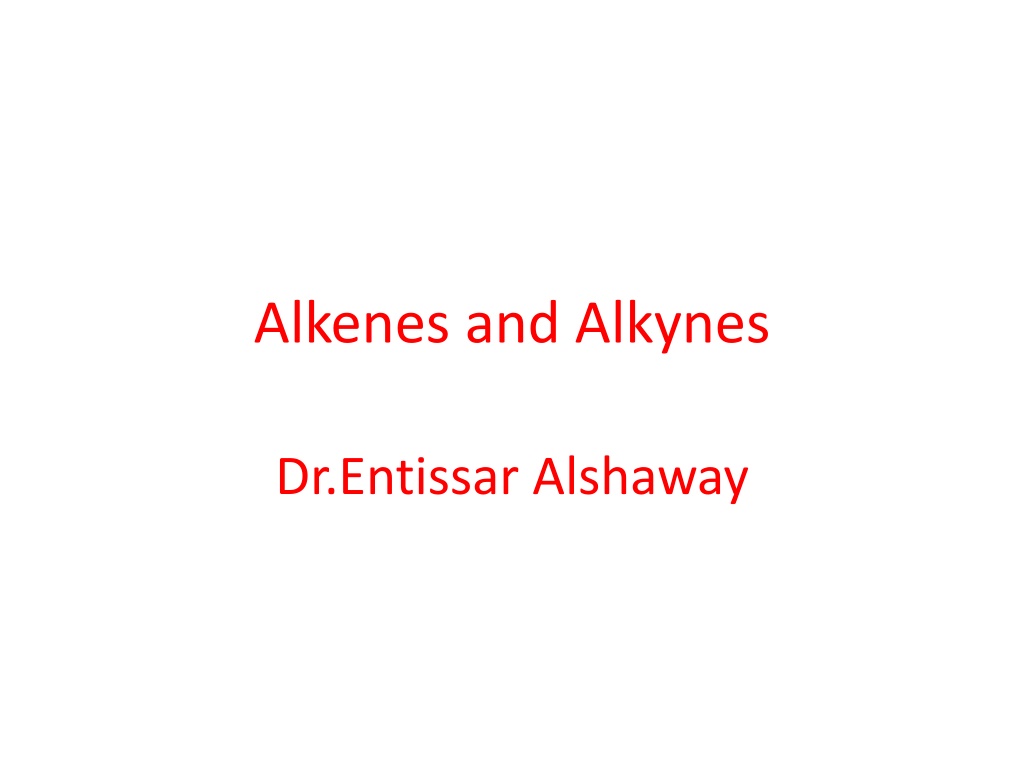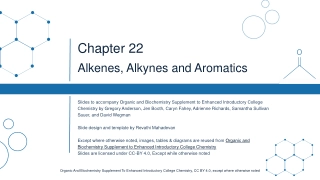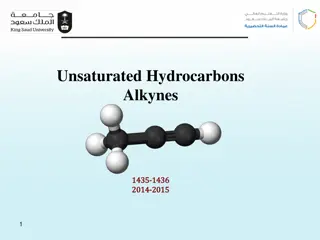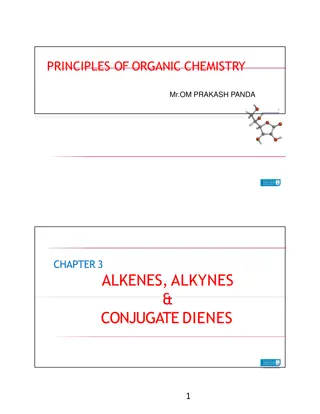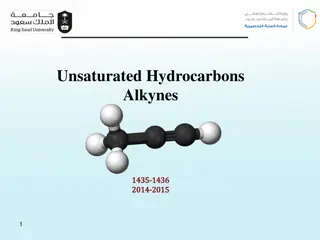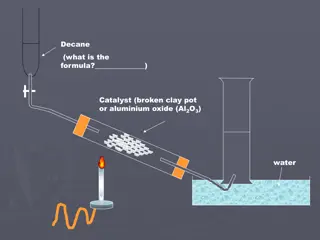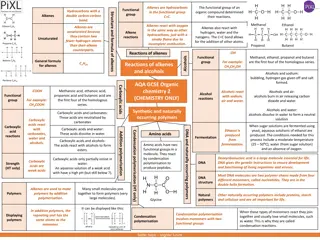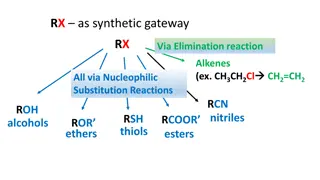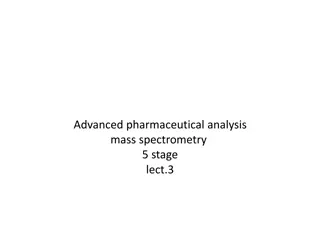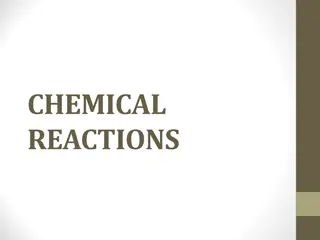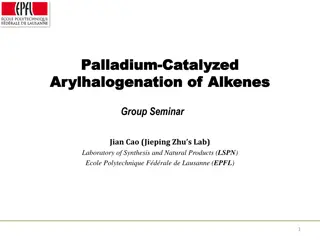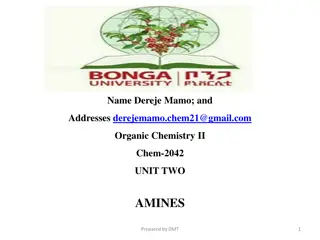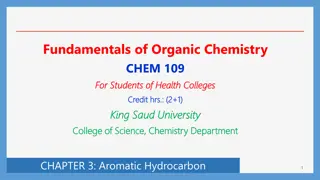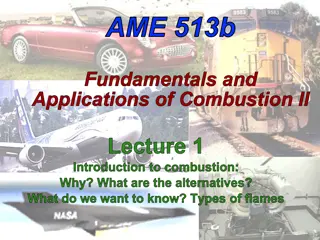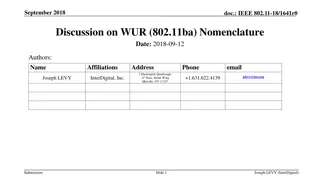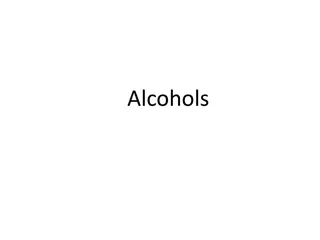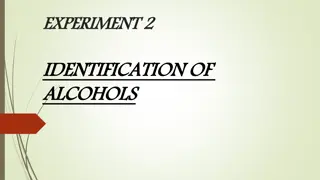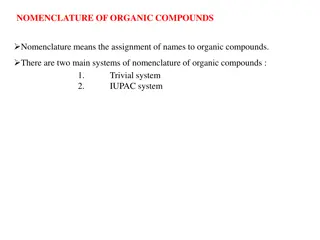Understanding Alkenes and Alkynes: Nomenclature, Reactions, and Preparations
Alkenes and alkynes are crucial types of unsaturated hydrocarbons with distinct characteristics. This content delves into their IUPAC nomenclature rules, preparation methods, qualitative tests, and reactions. It also explores naming conventions for alkenes and alkenyl groups, providing a comprehensive understanding of these compounds.
Download Presentation

Please find below an Image/Link to download the presentation.
The content on the website is provided AS IS for your information and personal use only. It may not be sold, licensed, or shared on other websites without obtaining consent from the author. Download presentation by click this link. If you encounter any issues during the download, it is possible that the publisher has removed the file from their server.
E N D
Presentation Transcript
Alkenes and Alkynes Dr.Entissar Alshaway
Learning objectives Alkenes (olefine) IUPAC Rules of nomenclature of alkenes Reactions Preparations. Alkynes (Acetylenes) IUPAC system of nomenclature of alkynes Preparation Reactions Qualitative tests
Alkenes Alkenes are unsaturated hydrocarbons which contain one carbon carbon double bond. Alkenes are characterized by sp2-hybridization and their double bond contains - and -bonds. General formula,CnH2n (n=2,3,---)
Naming Alkenes 1. Name the parent hydrocarbon by locating the longest carbon chain that contains the double bond and name it according to the number of carbons with the suffix -ene.
2.A- Number the carbons of the parent chain so the double bond carbons have the lowest possible numbers.
B. If the double bond is equidistant from each end, number so the first substituent has the lowest number
3. If more than one double bond is present, indicate their position by using the number of the first carbon of each double bond and use the suffix -diene (for 2 double bonds), -triene (for 3 double bonds), -tetraene (for 4 double bonds), etc.
4. a. Cycloalkenes are named in a similar way.Number the cycloalkene so the double bond carbons get numbers 1 and 2, and the first substituent is the lowest possible number.
b. If there is a substituent on one of the double bond carbons, it gets number 1.
Alkenyl group Alkenyl group is obtained by removing one hydrogen atom from an alkene. IUPAC name of the alkenyl group is given by replacing -ne of parent alkene with -yl. The carbon with free valence is always numbered first
Preparation of alkenes: 1-Dehydration of alcohol The dehydration reaction of alcohols to generate alkene proceeds by heating the alcohols in the presence of a strong acid, such as sulfuric or phosphoric acid, at high temperatures.
stability of ter.carbonium ion will be more than the sec.carboonium ion and that will be more stable than primary.
2-Dehydrohalogenation of alkyl halids: Treatment of an alkyl halide with conc.strong base,such as solid KOH dissolved in ethanol, lead to elimination of HX and formation of alkene:
3-Redaction of alkyne Alkynes can be reduced to alkenes using palladium supported over CaCO3 or BaSO4 and partially poisoned by addition of Sulphur or quinoline predominantly gives cis-alkenes which known as Lindlars reduction . Alkynes can also be reduced to trans-alkenes with sodium in liquid ammonia which is called Birch reduction
Reaction of alkenes Addition reaction 1- Addition of hydrogen :H2 Is the addition of hydrogen H-H (H2) to a carbon-carbon double bond ( -bond )to give an alkane. The reaction must be catalyzed by metals such as Pd, Pt, Rh, and Ni.
2-Electrophilic trans addition of halogen Halogens can act as electrophiles to attack a double bond in a lkene. Double bond represents a region of electron density and therefore functions as a nucleophile. How is it possible for a halogen to obtain positive charge to be an electrophile?
3-Adition of Hx(hydrohalogenation) The hydrogen of the HX is add to the carbon of the double bond containing the greatest number of hydrogen .This rule is called Markownikoff rule.
4-Addition of water The addition of water to the alkenes ,called hydration ,required the presence of a strong acid catalyst such as sulfuric acid or phosphoric acid
Oxidation reaction Oxidation of alkenes by KmnO4: Alkenes react with cold dilute alkaline potassium permanganate solution to form 1,2- diols called glycols.The glycols contain two OH groups on adjacent carbon atoms .This reaction of addition of two hydroxyl groups to each end of double bond is called hydroxylation of the double bond.
A hot acidic solution of KmnO4 is astrong oxidizing reagent that breaks both bonds of the double bond .The product s formed depended on the structure of the orginal alkene
Alkynes Alkynes contain a carbon carbon triple bond. Terminal alkynes have the triple bond at the end of the carbon chain so that a hydrogen atom is directly bonded to a carbon atom of the triple bond. Internal alkynes have a carbon atom bonded to each carbon atom of the triple bond. An alkyne has the general molecular formulaCnH2n-2, giving it four fewer hydrogens than the maximum possible for the number of carbons present. Thus, the triple bond introduces two degrees of unsaturation.
Preparation of alkynes 1-Dehydrohalogenation:- alkynes are prepared by elimination reactions. A strong base removes two equivalents of HX from a vicinal or geminal dihalide to yield an alkyne through two successive E2 elimination reactions.
2- Acetylis Terminal alkynes are weak acids .Reaction of strong anhydrous bases with a terminal acetylene produces an acetylide ion.
Acetylide ions can react as nucleophiles as well as bases Reaction with a primary alkyl halide produces a hydrocarbon that contains carbons from both partners, providing a general route to larger alkynes
Uses of acetylide ions 1-Qualitative Test for terminal alkynes. 2-Separation of a mixture of terminal and internal alkynes Terminal alkynes form a precipitate with Ag or Cu salts ,internal alkynes do not react Reaction with Ag(NH3)2NO2:
Oxidative Cleavage of Alkynes Strong oxidizing reagents (O3or KMnO4) cleave internal alkynes, producing two carboxylic acids Terminal alkynes are oxidized to a carboxylic acid and carbon dioxide
